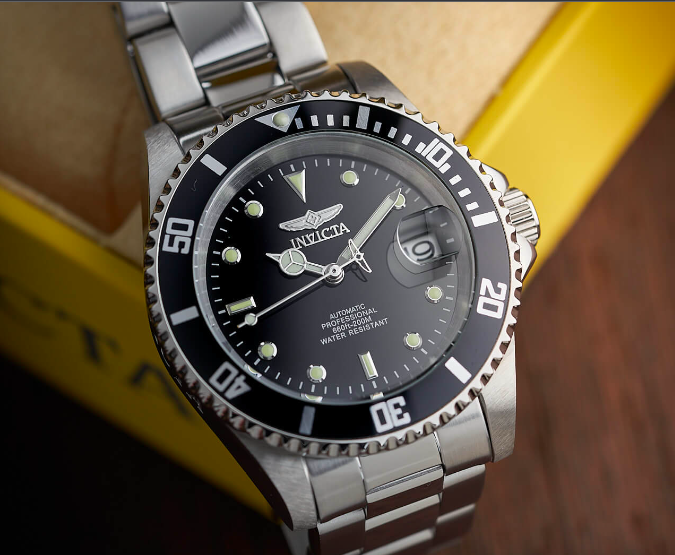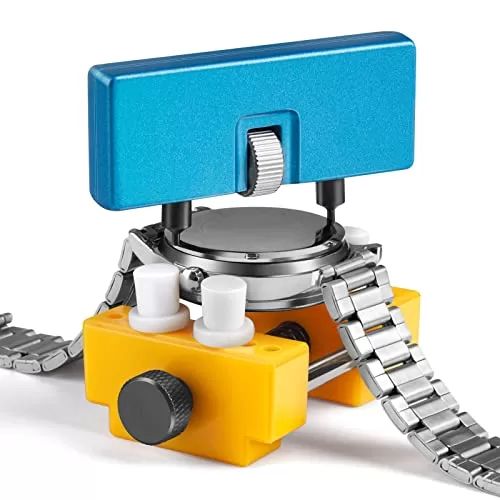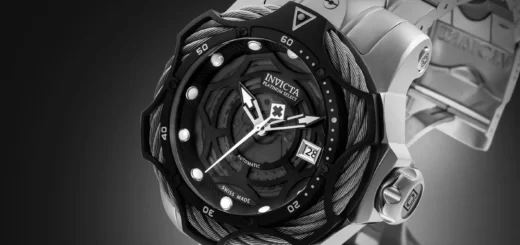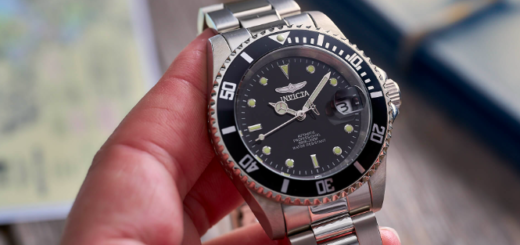How To Open Invicta Watches: Tips And Tricks To Follow
Opening an Invicta watch might seem like a daunting task, but it’s a valuable skill to have, especially for maintenance or battery replacement. Invicta watches are known for their durability and quality, but like all timepieces, they require occasional attention to keep them running accurately. In this guide, we’ll walk you through the process of safely opening Invicta watches, ensuring you can perform basic maintenance tasks and extend the lifespan of your timepiece.
Knowing how to open your Invicta watch can save you time and money in the long run. Rather than relying on a jeweler or watchmaker for routine tasks like battery replacements or minor repairs, you can perform these tasks yourself with the right knowledge and tools. This not only keeps your watch running smoothly but also allows you to maintain a personal connection with your timepiece. Additionally, understanding the internal components of your watch can help you detect issues early, preventing costly repairs down the road. So, how to open Invicta watches? In this guide, we’ll demystify the process and equip you with the skills needed to confidently open your Invicta watch.
Table of Contents
Tools and Materials Required to Open Your Invicta Watch

Before you begin the process of opening your Invicta watch, it’s essential to gather the right tools and materials. Here’s a list of what you’ll need:
- Case Back Opener: This specialized tool is designed to remove the case back without damaging the watch. There are various types available, such as wrench-style openers or case knives, so choose the one that best suits your watch model.
- Case Back Holder: A case back holder is used to secure the watch while you work on it, preventing any accidental slips or damage.
- Soft Cloth or Watchmaker’s Mat: Placing your watch on a soft surface helps protect its exterior from scratches during the opening process.
- Plastic Tweezers: These non-magnetic tweezers are useful for handling small components inside the watch without causing magnetization.
- Watchmaker’s Screwdrivers: Invest in a quality set of precision screwdrivers with various tips to ensure you have the right size for your watch’s screws.
- Anti-static Brush: This small brush is handy for removing dust and debris from the watch’s movement.
- Gloves: Optional but recommended, gloves keep oils and fingerprints off the watch components, especially the movement.
- Magnifying Glass or Loupe: A magnifying tool with a strong lens helps you see small details and ensure precision.
Using the correct tools is crucial to avoid damaging your Invicta watch while opening it. Invicta watches, like many high-quality timepieces, are intricate and finely crafted. Attempting to open them with improper tools, like household items or makeshift instruments, can lead to scratches, dents, or even permanent damage to the watch’s components.
Investing in the appropriate watchmaking tools ensures that you can access the interior of your watch safely and efficiently. It not only protects your timepiece but also preserves its value. Remember that a minor investment in the right tools can save you from costly repairs or the need for professional intervention. In the following sections, we’ll guide you through the step-by-step process of opening your Invicta watch using these tools and materials.
Identifying the Watch Case Back
Invicta watches come with different types of case backs, each requiring a specific approach for opening:
- Screw-Down Case Back: Some Invicta models feature a screw-down case back. These case backs have a series of fine threads that screw tightly onto the case to ensure water resistance. To open a screw-down case back, you’ll need a case back opener with the appropriate tips.
- Snap-On Case Back: Snap-on case backs are more common in Invicta watches. They simply snap onto the case and are held in place by small tabs or notches around the edge. Opening a snap-on case back typically requires a case knife or specialized case back opener.
- Exhibition Case Back: Invicta offers watches with exhibition case backs, allowing you to view the movement. These case backs are often screw-down or snap-on and may have a transparent crystal to protect the movement.

Identifying the type of case back on your Invicta watch is essential before you proceed with opening it. Here’s how to determine the specific type:
- Check the Documentation: If you have the watch’s manual or paperwork that came with it, it may mention the type of case back. Look for terms like “screw-down,” “snap-on,” or “exhibition.”
- Examine the Case Back: Inspect the back of your watch closely. A screw-down case back will typically have notches or small indentations around the edge for a case back opener. A snap-on case back, on the other hand, may have a small gap between the case back and the case, indicating where you can insert a case knife or opener.
- Consult Invicta’s Website: Visit Invicta’s official website and search for your watch model. The product description or specifications may include information about the case back type.
- Seek Professional Advice: If you’re uncertain about the type of case back or feel uncomfortable identifying it yourself, consider consulting a professional watchmaker or a jeweler. They can help you determine the best method for opening your specific watch.
Once you’ve identified the type of case back, you can proceed with the appropriate method for safely opening your Invicta watch. In the following sections, we’ll provide step-by-step instructions for both screw-down and snap-on case backs.
Opening Snap-On Case Backs
Opening a snap-on case back on your Invicta watch requires precision and the right tools. Here’s a step-by-step guide to safely access the inner components:
Step 1: Gather Your Tools and Workspace
- Ensure you have a clean and well-lit workspace.
- Use a case back opener or a case knife designed for snap-on case backs.
- Keep a soft cloth or watchmaker’s pad handy to protect the watch’s surface.
Step 2: Identify the Notch
- Examine the edge of the case back carefully. Look for a small notch or gap between the case back and the case itself. This is where you’ll insert your tool.
Step 3: Insert the Tool
- Gently insert the case knife or opener into the notch. Be cautious not to force it; it should fit snugly without excessive pressure.
Step 4: Apply Steady Pressure
- With the tool in place, apply steady and even pressure while maintaining control over the watch. Do not rush this step, as forcing the case back can cause damage.
Step 5: Rotate the Tool
- Begin to rotate the tool counterclockwise slowly. As you turn, you should feel the resistance decrease as the tabs or notches holding the case back in place disengage.
Step 6: Remove the Case Back
- Once you’ve rotated the tool sufficiently, the case back will pop off. Be prepared to catch it to prevent it from falling and getting scratched.
Step 7: Perform Maintenance
- With the case back removed, you can access the watch’s movement for battery replacement, cleaning, or other maintenance tasks.
Using the correct tools, such as a case back opener or a case knife, is crucial when opening snap-on case backs. Here’s why it’s essential:
- Prevents Damage: Invicta watches, like any fine timepiece, are delicate. Using the right tools ensures that you don’t damage the case back or the watch’s surface during the opening process.
- Preserves Water Resistance: Snap-on case backs often play a role in maintaining a watch’s water resistance. Using improper tools can compromise this feature, potentially allowing moisture to enter the watch.
- Safety: The correct tools provide better control, reducing the risk of accidents or injuries during the opening process.
- Professional Results: When you use the appropriate tools, you’re more likely to achieve professional-looking results. This is especially important if you plan to perform maintenance or replace components inside the watch.
Remember that if you’re uncomfortable with this process or have any doubts, it’s always a good idea to seek assistance from a professional watchmaker or a jeweler who has experience working with snap-on case backs. They can ensure your watch is opened safely and efficiently.
Opening Screw-Down Case Backs
Screw-down case backs are commonly found on dive and sports watches, including many Invicta models. Opening them requires a bit more effort and a specialized tool, a case back wrench. Here’s how to do it safely:
Step 1: Gather Your Tools and Prepare the Workspace
- Ensure you have a clean and well-lit workspace.
- Acquire a case back wrench designed for your watch’s size and style.
- Keep a soft cloth or watchmaker’s pad nearby to protect the watch’s surface.
Step 2: Identify the Case Back
- Examine the back of your Invicta watch to confirm that it has a screw-down case back. Look for small slots or notches around the edge, which indicate a screw-down design.
Step 3: Prepare the Case Back Wrench
- Adjust the case back wrench to fit the slots on the case back securely but not too tightly. Ensure it is aligned properly.
Step 4: Apply Counter-Clockwise Pressure
- Holding the watch securely, apply counter-clockwise (leftward) pressure with the case back wrench while keeping the watch steady. Make sure to use consistent and controlled force.
Step 5: Turn the Wrench
- Begin turning the wrench slowly, applying continuous pressure. You should feel the resistance decrease as the threads on the case back start to disengage.
Step 6: Unscrew the Case Back
- Continue turning until the case back is entirely unscrewed. Be prepared to catch it when it comes loose.
Step 7: Perform Maintenance
- With the screw-down case back removed, you can access the watch’s movement for battery replacement, cleaning, or other necessary maintenance tasks.
Using a Case Back Wrench
A case back wrench is a specialized tool designed for opening screw-down case backs. Here’s why it’s essential and how to use it:
Importance of a Case Back Wrench:
- Proper Fit: A case back wrench is adjustable to fit different watch models, ensuring a secure grip on the case back without causing damage.
- Control: Using a wrench provides precise control over the opening process, reducing the risk of slipping and scratching the watch.
- Preservation of Water Resistance: Watches with screw-down case backs often have gaskets that provide water resistance. A case back wrench allows you to maintain this seal, preventing moisture from entering the watch.
How to Use a Case Back Wrench:
- Adjustment: Ensure the case back wrench is correctly adjusted to fit the notches or slots on the case back. It should grip securely but not too tightly.
- Counter-Clockwise Pressure: Apply counter-clockwise (leftward) pressure with the wrench while keeping the watch steady.
- Controlled Turning: Turn the wrench slowly, applying steady force. As the threads on the case back disengage, you will feel reduced resistance.
- Catch the Case Back: Be ready to catch the case back when it comes loose to prevent it from falling and getting scratched.
By using a case back wrench correctly, you can safely and effectively open screw-down case backs on your Invicta watch, allowing for maintenance or battery replacement when needed.
Safety Tips While Opening Your Invicta Watch
When opening your Invicta watch, it’s crucial to follow these safety tips to prevent damage and ensure a successful procedure:
1. Use the Right Tools: Always use appropriate and high-quality watchmaking tools. Using makeshift or improper tools can result in scratches or damage to your watch.
2. Work on a Clean Surface: Choose a clean, well-lit workspace with adequate room to lay out your tools. A clutter-free environment reduces the risk of losing small components.
3. Be Gentle: Apply controlled force when using tools, especially when opening snap-on case backs or handling delicate components. Avoid excessive pressure, which can lead to damage.
4. Protect the Watch: Place a soft cloth or watchmaker’s pad beneath your watch to protect its finish from scratches during the procedure.
5. Avoid Magnetism: Keep your watch away from strong magnets, as magnetism can interfere with the movement’s accuracy.
6. Beware of Dust and Debris: Ensure your workspace is free from dust, lint, or debris that can enter the watch and affect its movement.
7. Maintain Water Resistance: If your watch is designed for water resistance, take extra care when reassembling it to preserve its sealing gaskets and maintain water-resistant properties.
8. Proper Screw Handling: If your watch requires the removal of screws, use appropriate screwdrivers and keep track of the screws to avoid loss.
Delicate internal components inside your Invicta watch require careful handling to prevent damage. Here are some tips:
1. Hands and Dial: Avoid touching the hands and dial unnecessarily. If adjustments are needed, use proper tools like hand-setting levers or tweezers designed for watchmaking.
2. Movement: Handle the movement with clean, dry hands or wear lint-free gloves to prevent contamination. Avoid unnecessary contact with the movement’s delicate parts.
3. Battery Replacement: When replacing a watch battery, be gentle with the battery contacts and ensure proper alignment. Follow the watch’s technical documentation for guidance.
4. Gaskets and Seals: If your watch features gaskets and seals for water resistance, take care not to damage or displace them during disassembly and reassembly. Lubricate gaskets when necessary to maintain their effectiveness.
5. Anti-Magnetic Tools: Consider using anti-magnetic tools when working with the movement, especially if you have magnetic-sensitive components in your watch.
6. Anti-Static Measures: If possible, work on an anti-static mat and use anti-static tweezers to minimize the risk of static discharge that can harm delicate components.
7. Consult a Professional: If you’re unsure about handling certain watch components, especially complex movements or intricate repairs, it’s best to consult a professional watchmaker to avoid accidental damage.
By following these safety tips, you can open your Invicta watch with confidence, perform maintenance or battery replacements when needed, and ensure that your timepiece remains in excellent condition.
Common Mistakes to Avoid While Opening Your Invicta Watch
While attempting to open Invicta watches, individuals often make common mistakes that can lead to complications or damage. Recognizing these errors is crucial to prevent them:
1. Using Incorrect Tools: Using improper tools not designed for watchmaking can result in scratched cases, damaged case backs, or broken components. Always use specialized watchmaking tools.
2. Applying Excessive Force: Applying too much force when opening snap-on case backs or removing screws can cause slips and scratches, potentially damaging the watch’s exterior.
3. Skipping Proper Identification: Failing to correctly identify the type of case back (snap-on, screw-down, etc.) can lead to incorrect opening methods, which may damage the watch or case back threads.
4. Neglecting Dust and Debris: Working in a dusty or cluttered environment increases the risk of dust and debris entering the watch, potentially affecting its movement’s performance.
5. Mishandling the Movement: Touching the movement’s delicate components with bare hands can introduce oils, dirt, or contaminants. Mishandling can also lead to misalignment or damage to the movement.
6. Ignoring Water Resistance: Neglecting water-resistant gaskets or seals during reassembly may compromise the watch’s water resistance, rendering it vulnerable to moisture damage.
7. Over-Tightening Screws: When reassembling the watch, over-tightening screws can strip threads or damage the case, making future repairs challenging.
These common mistakes can result in various consequences, impacting both the aesthetics and functionality of your Invicta watch:
1. Aesthetic Damage: Scratches, dents, or scuffs on the case, crystal, or dial can diminish the watch’s appearance and resale value.
2. Movement Issues: Mishandling the movement or failing to maintain a clean environment may introduce contaminants, affecting the movement’s accuracy or causing it to malfunction.
3. Water Damage: Neglecting proper sealing during reassembly can compromise the watch’s water resistance, making it vulnerable to moisture and potentially damaging internal components.
4. Difficulty in Repairs: Stripping threads or over-tightening screws can make future repairs or servicing more challenging, potentially increasing repair costs.
To avoid these pitfalls, take your time, use the correct tools, and follow the recommended procedures when opening your Invicta watch. When in doubt, consider seeking assistance from a professional watchmaker to ensure the safety and integrity of your timepiece.

Reassembling the Watch
Once you’ve completed the necessary maintenance or repairs on your Invicta watch, it’s vital to reassemble it correctly to ensure its proper function and maintain its water resistance. Here’s a step-by-step guide:
- Clean Components: Before reassembly, make sure all components, including the case back and gaskets, are clean and free of debris. Any contaminants can compromise the watch’s performance.
- Inspect Gaskets: Check the condition of the gaskets, especially on screw-down case backs. Replace any damaged or worn gaskets with suitable replacements to maintain water resistance.
- Position the Movement: Carefully place the movement back into the watch case, ensuring it aligns correctly with the dial and hands. Avoid touching the movement with your fingers to prevent introducing oils or contaminants.
- Secure the Movement: If the movement requires securing screws, tighten them gently but securely according to the manufacturer’s specifications. Be cautious not to over-tighten, as this can damage the case or movement.
- Reattach the Case Back: For snap-on case backs, position the case back over the watch and press it firmly into place. Ensure it snaps securely. For screw-down case backs, use a case back wrench to screw it back onto the case, being careful not to cross-thread the screws.
- Test Water Resistance: If your Invicta watch is water-resistant, it’s essential to perform a water-resistance test after reassembly. Submerge the watch in water (without pressing any buttons or using the crown) and check for any signs of water ingress. If you’re uncertain about the watch’s water resistance, consult a professional.
- Check Functions: Verify that all watch functions, including timekeeping, date changes (if applicable), and any additional features, work correctly.
- Inspect for Aesthetics: Examine the watch’s exterior for any cosmetic imperfections, such as scratches or smudges. Clean and polish the case and crystal as needed.
Proper reassembly is critical to maintaining your Invicta watch’s water resistance. Failure to reseal the watch correctly can allow moisture to enter, potentially causing irreversible damage to the movement and other internal components.
To ensure the watch remains water-resistant:
- Always inspect and replace gaskets if they show signs of wear or damage.
- Screw down screw-down case backs securely, taking care not to cross-thread the screws.
- For snap-on case backs, ensure they snap into place securely, with no gaps.
- After reassembly, perform a water-resistance test to confirm that the watch can withstand its rated depth.
Remember that not all Invicta watches are designed for deep-sea diving, so adhere to the manufacturer’s recommended water resistance limits. If you have any doubts about the watch’s water resistance or reassembly process, it’s advisable to seek assistance from a professional watchmaker or authorized service center to maintain the integrity of your timepiece.
Parting Thoughts
Knowing how to open an Invicta watch is a valuable skill for watch enthusiasts who wish to perform maintenance, battery replacements, or simply explore the inner workings of their timepieces.
While this guide provides valuable insights into opening Invicta watches, it’s crucial to approach the process with care and confidence. If you’re ever uncertain about any aspect of opening or reassembling your watch, especially if it involves intricate movements or maintaining water resistance, consider seeking assistance from a professional watchmaker or an authorized service center.
Remember that every watch, including Invicta timepieces, has its unique design and characteristics, so it’s wise to consult the manufacturer’s instructions or reach out to their customer support for specific guidance. By combining your newfound knowledge with professional expertise when needed, you can ensure the longevity and performance of your Invicta watch while enjoying the art and mechanics of horology.



